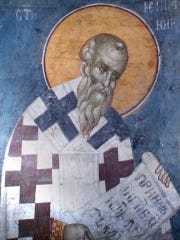QDST
Holy
Editorial Note:
The following is a 600 word essay analyzing the label of the 2nd week of the Great Fast, or Lent, in the EOTC. The first s used in silasé and silus corresponds to the Hebrew letter ש (sheen), and even visually looks like it in the Babylonian Aramaic script most Hebrew we know uses, which is historically an sh rather than an s. Whereas the second s corresponds to the Hebrew letter ס (samech) which is just an as. In ge’ez, these are respectively called nigusu se (the kingly s) and isatu se (the fiery s), because they are frequently found in these words. Negash, my paternal grandfather’s given name, is a form of nigus that retains the historic sh.
Written by: Dcn. Nahom Selomon
ቅድስት (qdst), a ge’ez word with a feminine conjugation, means holy/holiness. In most Classical Ethiopic texts, the term serves as a prefix to a woman saint (ex: ቅድስት ዕሌኒ qdst ilénee; Saint Helen). It is also used in reference to the Holy Trinity, ቅድስት ሥላሴ (qdst silasé); who is also addressed in the masculine ሥሉስ ቅዱስ (silus qdus). qdst is also a stand alone given name.
The cycle of the Lenten season starts with the first week (second, depending on how you count) qdst according to the hymnal of Saint Yaréd the Aksumite. Though we can not interview the Great Composer to inquire about the naming of this week, we can infer from the collected writings of the week that it centers on the holiness of God, Heaven, Zion, the Virgin Mary, the new sabbath, the church, and all things in creation.
What is holiness?
In the Classical Ethiopic Tradition, unique, special, distinguished, different, set apart (ልዩ liyu; Amharic) is used to translate qdst. The English word holy, on the other hand, has close ties to wholeness, totality, completeness, intactness, and incorruption.
As the Essence of God is unsearchable, the word holy is all-encompassing and communicates the essence of the atemporal and immutable attributes of elohym (God).
Further, Scripture says…
"No one is holy like the Lord, for there is none besides You," (1 Samuel 2:2 NKJV). This is also reflected in Ethiopian Liturgical Services, wherein we imitate the angels’ worship, “Holy Holy Holy.”(Isaiah 6:3)
If God is holy, it is sound to conclude that all his creation is holy. This is foundational to Orthodoxy in that no hope of attaining the wholeness of the original image renders the rituals, works, and purpose of our existence void.
Why?
What makes something holy?
All creation partakes of the holiness of God. That means their wholeness is but an effect of their associative contact with God the (W)Holy One. As pinnacles of creation, this is even more true with humans. Humans, made in the image and likeness of the Triune God, (Genesis 1:26-27) are replicas of The Whole, The Intact, and The Incorrupt.
In His letters, Saint Peter reminded his recipients that holiness is the aim of us being "begotten again from God"(1st Peter 1:3), reiterating the proclamation of God from Leviticus, "Be Holy for I am Holy." (Leviticus 11:44; 1st Peter 1:16)
What is expected of us to remember and enact in the week of Holy?
As highlighted in the week before, the image of holiness became available to us through the incarnation of the Son of God, Jesus Christ. The coming of the Son of Man was powerful in that the embodiment of all virtue and wisdom was accessible to all. The Lectionary of the Sunday of qdst employs the Anaphora of Saint Epiphanius.
In the Prayer of the Fraction, we find a fulfillment of the Proverbs of King Solomon,
Wisdom (feminine) has built her house; she has hewn out its seven pillars. She has prepared her meat and mixed her wine; she has also set her table. She has sent out her maids, and she calls from the highest point of the city.Let all who are simple come in here! she says to those who lack judgment. Come, eat my food and drink the wine I have mixed. Leave your simple ways and you will live; walk in the way of understanding.
The author of the anaphora finally concludes the prayer of the fraction with...
Wisdom is Our Savior (Christ), who atoned for us with the butchering of his flesh and bought us by the spilling of his blood.
A shift from feminine to.... masculine?
If seeking wisdom (the feminine) is a prefiguring of seeking Christ, then maybe seeking qdst is the same? Though we cannot make rational deductions of why that shift was chosen by the author, or editor, we can retain that seeking qdst and seeking Christ are the same.
May the Lord will you to bear repentance-worthy fruits.

